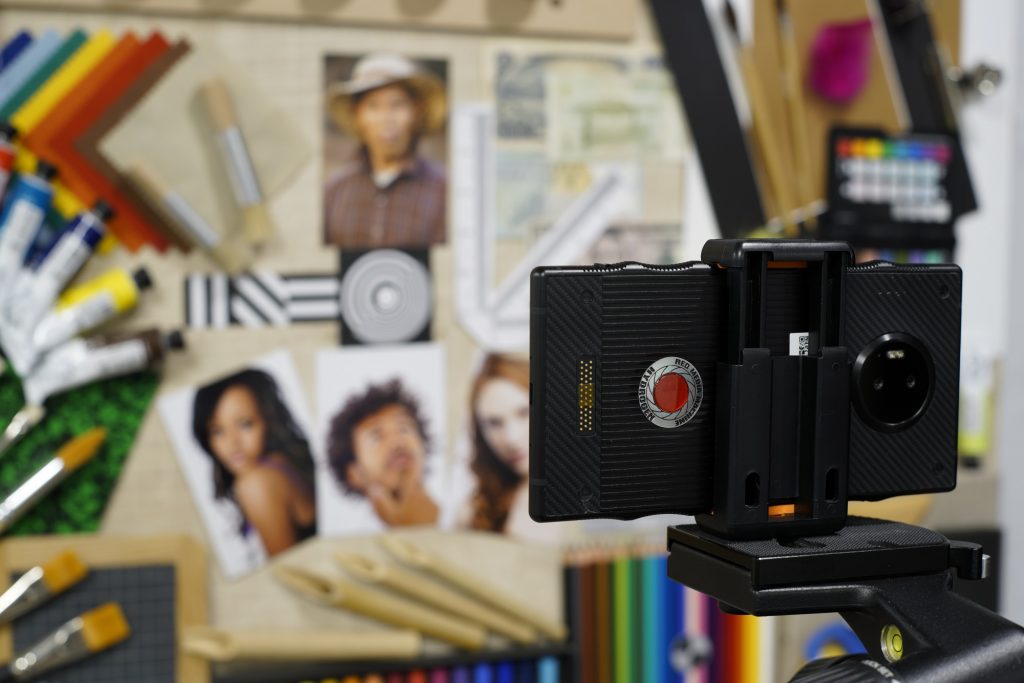After a number of pre-announcements and a lot of hype, high-end camera maker RED today officially launched its RED HYDROGEN One Media Machine. We were very interested to see what HYDROGEN was, primarily because the RED 8K Helium digital cinema camera recorded the highest DxOMark Sensor score ever (https://www.dxomark.com/red-helium-8k-dxomark-sensor-score-108-a-new-all-time-high-score2/). RED says the HYDROGEN One isn’t just a smartphone, but rather a tool for content creators. Looking at the specifications, feature set, and module roadmap, it seems the company has set some pretty high goals.
Display
The device’s headline feature is its Holographic 4-View (H4V) capability. The 5.7” QHD display allows for multi-dimensional viewing without special glasses of any kind. In contrast to previous attempts at glasses-free 3D using lenticular technology, HYDROGEN uses the new Leia nanotech display, which is a clear substrate under the LCD that captures 4 distinct views in both landscape and portrait orientations (does not affect 2D mode).
Camera
HYDROGEN has paired stereo cameras front and back, which makes it capable of shooting both 2D and 4-View (.h4v) still or video images from either side of the device. 4-View, which the company says is “better than 3D without glasses,” is accomplished by capturing stereo image pairs, creating a depth map in real time and generating two additional views leading to the 4-View final .h4v. Another thing we found interesting is that the .h4v still image is packaged as a conventional 2D jpeg plus metadata for the additional views. This means that an .h4v file can be opened or shared just like any other 2D jpeg. HYDROGEN owners will see the image in 4-View and everyone else will see normal resolution 2D. In 2D mode, HYDROGEN can also utilize the stereo pair cameras for its bokeh mode. HYDROGEN uses the generated depth map from the two cameras to create a focus falloff effect. We are eager to test it with our DxOMark Mobile protocol to see how it performs versus other bokeh-enabled smartphones.
Currently the only file format for 4-View is .h4v, although we are told that a more professional SBS 4K-by-4K option (useful for grading and archiving) is coming with the next system update. Also due in an update is the ability to create a variable bokeh strength in 4-View images. When shooting video, users will be able to select from a range of new frame rate options and use very high data rates of up to 100 Mbps.
Sharing 4-View
The device comes with the RED/LeiaLoft on the home screen that allows you to download Holographic 4-View applications for sharing, such as Holopix, an Instagram-like app for the 4-View community. You can also find 4-View games on RED/LeiaLoft. Verizon Messages, found on Google Play Store, supports 4-View texting between HYDROGEN owners. Everyone else sees normal-resolution 2D images from the same file. RED has announced that a “Holochat” application is coming soon that will allow 4-View video chat between customers.
Sound
With Multi-Dimensional Surround Sound, the HYDROGEN One’s sound capabilities are on par with the visuals. A proprietary A3D algorithm converts audio into what Red calls SuperExpansive Spatial Sound that listeners can enjoy with or without headphones — no additional surround sound speakers or other equipment are required.
Modularity
The HYDROGEN One is designed as a modular smartphone, similar to what we’ve seen with the Motorola Moto Z series and with the LG G5’s pogo pin array on the back for connectivity. RED says that future modules include a cinema-quality camera with a sensor designed by the RED camera team.
Additionnal Notes
HYDROGEN comes with an industrial design that sets it apart from the crowd. The scallops on the sides make it very easy to hold. It has a very large 4500mA battery, a headphone jack, and a tool-less SIM card/Micro SD card tray. The combination of large battery and additional Micro SD card slot are clearly targeted for consumers taking a lot of photos or long videos.
The company made it clear to us that there will be regular updates to further improve image quality and to add additional features and capabilities to the phone. Given RED’s history with their cinema cameras, we would expect nothing less.
2D Imaging Performance – Preliminary Findings
Our DxOMark engineers have had a chance to have a first look at the device with pre-production software, and while we don’t currently have the capability to score the new 4-View technology with our DxOMark Mobile protocol, it’s fair to say the technology looks extremely impressive and is currently unique on the market. The software definitely has some rough edges that RED needs to clean up, which is to be expected from a first-time cell phone manufacturer.
We did have a go at examining the camera’s 2D imaging capabilities, however, and we were particularly impressed by the AF performance and a very good balance between detail preservation and noise reduction. The experience of having a bokeh mode in both 2D and 4V is truly remarkable. The addition of being able to capture 4-View images and display and share them makes this phone a compelling option.
After the official release of the software update, we hope to run the HYDROGEN through our complete battery of DxOMark tests and to publish the results thereafter.



DXOMARK encourages its readers to share comments on the articles. To read or post comments, Disqus cookies are required. Change your Cookies Preferences and read more about our Comment Policy.